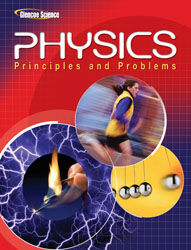1 If the radius of the CD below is 6.0 cm and the angular velocity is 5.0 rad/s, what is its angular displacement in 2.0 s?
<a onClick="window.open('/olcweb/cgi/pluginpop.cgi?it=jpg::::/sites/dl/free/0078807220/617916/lr.JPG','popWin', 'width=NaN,height=NaN,resizable,scrollbars');" href="#"><img valign="absmiddle" height="16" width="16" border="0" src="/olcweb/styles/shared/linkicons/image.gif"> (6.0K)</a> A) 6.0×101 rad B) 1.7 rad C) 0.60 rad D) 1.0×101 rad 2 A) orbiter B) rigid rotating object C) projectile D) satellite 3 If the radius of the CD below is 6.0 cm and the angular velocity is 5.0 rad/s, what is the linear displacement of a point on the edge in 2.0 s?
<a onClick="window.open('/olcweb/cgi/pluginpop.cgi?it=jpg::::/sites/dl/free/0078807220/617916/lr.JPG','popWin', 'width=NaN,height=NaN,resizable,scrollbars');" href="#"><img valign="absmiddle" height="16" width="16" border="0" src="/olcweb/styles/shared/linkicons/image.gif"> (6.0K)</a> A) 60 m B) 0.30 m C) 0.60 m D) 3.8 m 4 If the door below is 0.90 m wide and you exert a force of 2.0 N, what is the magnitude of the resulting torque?
<a onClick="window.open('/olcweb/cgi/pluginpop.cgi?it=jpg::::/sites/dl/free/0078807220/617916/ls.JPG','popWin', 'width=NaN,height=NaN,resizable,scrollbars');" href="#"><img valign="absmiddle" height="16" width="16" border="0" src="/olcweb/styles/shared/linkicons/image.gif"> (2.0K)</a> A) 1.8 N·m B) 0.40 N·m C) 2.9 N·m D) 0.45 N·m 5 Why does applying a force as in the picture below result in no angular acceleration?
<a onClick="window.open('/olcweb/cgi/pluginpop.cgi?it=jpg::::/sites/dl/free/0078807220/617916/lt.JPG','popWin', 'width=NaN,height=NaN,resizable,scrollbars');" href="#"><img valign="absmiddle" height="16" width="16" border="0" src="/olcweb/styles/shared/linkicons/image.gif"> (2.0K)</a> A) The force is applied perpendicular to the axis of rotation. B) The force is applied parallel to the lever arm. C) The force is applied at the axis of rotation. D) The force is applied perpendicular to the lever arm. 6 Why does applying a force as in the picture below result in no angular acceleration?
<a onClick="window.open('/olcweb/cgi/pluginpop.cgi?it=jpg::::/sites/dl/free/0078807220/617916/ls.JPG','popWin', 'width=NaN,height=NaN,resizable,scrollbars');" href="#"><img valign="absmiddle" height="16" width="16" border="0" src="/olcweb/styles/shared/linkicons/image.gif"> (2.0K)</a> A) The force is applied perpendicular to the axis of rotation. B) The force is applied at the axis of rotation. C) The force is applied parallel to the lever arm. D) The force is applied perpendicular to the lever arm. 7 A) It is in static equilibrium. B) It accelerates. C) It is in velocity equilibrium. D) It is in angular equilbrium. 8 A) torque B) orbit C) center of mass D) axis 9 A) gravity B) low pressure areas C) the rotation of Earth D) winds 10 A) rotational equilibrium B) translational equilibrium C) static equilibrium D) equilibrium 11 A) rotational equilibrium B) static equilibrium C) translational equilibrium D) equilibrium 12 A) a high center of mass and a narrow base. B) a high center of mass and a narrow base. C) a high center of mass and a large base. D) a low center of mass and a large base. 13 A) in nonaccelerated or inertial frames B) in vacuum C) on Earth D) in rotating frames














